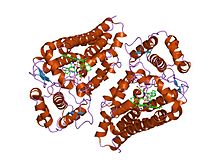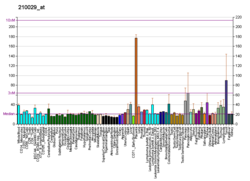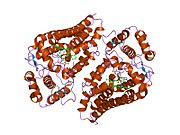| Indoleamine 2,3-dioxygenase | |||||||||
|---|---|---|---|---|---|---|---|---|---|
 crystal structure of 4-phenylimidazole bound form of human indoleamine 2,3-dioxygenase | |||||||||
| Identifiers | |||||||||
| Symbol | IDO | ||||||||
| Pfam | PF01231 | ||||||||
| Pfam clan | CL0380 | ||||||||
| InterPro | IPR000898 | ||||||||
| PROSITE | PDOC00684 | ||||||||
| |||||||||
| Indoleamine 2,3-dioxygenase | |||||||||
|---|---|---|---|---|---|---|---|---|---|
| Identifiers | |||||||||
| EC no. | 1.13.11.52 | ||||||||
| CAS no. | 9014-51-1 | ||||||||
| Databases | |||||||||
| IntEnz | IntEnz view | ||||||||
| BRENDA | BRENDA entry | ||||||||
| ExPASy | NiceZyme view | ||||||||
| KEGG | KEGG entry | ||||||||
| MetaCyc | metabolic pathway | ||||||||
| PRIAM | profile | ||||||||
| PDB structures | RCSB PDB PDBe PDBsum | ||||||||
| Gene Ontology | AmiGO / QuickGO | ||||||||
| |||||||||
Indoleamine-pyrrole 2,3-dioxygenase (IDO or INDO EC 1.13.11.52) is a heme-containing enzyme physiologically expressed in a number of tissues and cells, such as the small intestine, lungs, female genital tract or placenta. [5] In humans is encoded by the IDO1 gene. [6] IDO is involved in tryptophan metabolism. It is one of three enzymes that catalyze the first and rate-limiting step in the kynurenine pathway, the O2-dependent oxidation of L-tryptophan to N-formylkynurenine, the others being indolamine-2,3-dioxygenase 2 (IDO2) [7] and tryptophan 2,3-dioxygenase (TDO). [8] IDO is an important part of the immune system and plays a part in natural defense against various pathogens. [9] [10] It is produced by the cells in response to inflammation and has an immunosuppressive function because of its ability to limit T-cell function and engage mechanisms of immune tolerance. [11] Emerging evidence suggests that IDO becomes activated during tumor development, helping malignant cells escape eradication by the immune system. Expression of IDO has been described in a number of types of cancer, such as acute myeloid leukemia, ovarian cancer or colorectal cancer. IDO is part of the malignant transformation process and plays a key role in suppressing the anti-tumor immune response in the body, so inhibiting it could increase the effect of chemotherapy as well as other immunotherapeutic protocols. [12] [13] [14] Furthermore, there is data implicating a role for IDO1 in the modulation of vascular tone in conditions of inflammation via a novel pathway involving singlet oxygen. [15]
Physiological function
Indoleamine 2,3-dioxygenase is the first and rate-limiting enzyme of tryptophan catabolism through the kynurenine pathway.
IDO is an important molecule in the mechanisms of tolerance and its physiological functions include the suppression of potentially dangerous inflammatory processes in the body. [16] IDO also plays a role in natural defense against microorganisms. Expression of IDO is induced by interferon-gamma, which explains why the expression increases during inflammatory diseases or even during tumorigenesis. [17] Since tryptophan is essential for the survival of pathogens, the activity of enzyme IDO destroys them. Microorganisms susceptible to tryptophan deficiency include bacteria of genus Streptococcus [18] or viruses such as herpes simplex [19] or measles. [20]
One of the organs with high IDO expression is the placenta. In the 1990s, the immunosuppressive function of this enzyme was first described in mice due to the study of placental tryptophan metabolism. Thus, mammalian placenta, due to intensive tryptophan catabolism has the ability to suppress T cell activity, thereby contributing to its position of immunologically privileged tissue. [21]
Clinical significance
IDO is an immune checkpoint molecule in the sense that it is an immunomodulatory enzyme produced by alternatively activated macrophages and other immunoregulatory cells. [22] IDO is known to suppress T and NK cells, generate Tregs and myeloid-derived suppressor cells, and also supports angiogenesis. [12]
These mechanisms are crucial in the process of carcinogenesis. IDO allows tumor cells to escape the immune system by two main mechanisms. The first mechanism is based on tryptophan depletion from the tumor microenvironment. [23] The second mechanism is based on the production of catabolic products called kynurenins, that are cytotoxic for T lymphocytes and NK cells. [24] Overexpression of human IDO (hIDO) is described in a variety of human tumor cell lineages and is often associated with poor prognosis. [25] [26] Tumors with increased production of IDO include prostate, ovarian, lung or pancreatic cancer or acute myeloid leukemia. [27] [28] Expression of IDO is under physiological conditions regulated by the Bin1 gene, which can be damaged by tumor transformation. [29]
Emerging clinical studies suggest that combination of IDO inhibitors with classical chemotherapy and radiotherapy could restore immune control and provide a therapeutic response to generally resistant tumors. Enzyme IDO used by tumors to escape immune surveillance is currently in focus of research and drug discovery efforts, [30] as well as efforts to understand if it could be used as a biomarker for prognosis. [31]
Inhibitors
COX-2 inhibitors down-regulate indoleamine 2,3-dioxygenase, leading to a reduction in kynurenine levels as well as reducing proinflammatory cytokine activity.[ citation needed]
1-Methyltryptophan is a racemic compound that weakly inhibits indoleamine dioxygenase, but is also a very slow substrate. The specific racemer 1-methyl-D-tryptophan (known as indoximod) is in clinical trials for various cancers.
Epacadostat (INCB24360), navoximod (GDC-0919), and linrodostat (BMS-986205) are potent inhibitors of the indoleamine 2,3-dioxygenase enzyme and are in clinical trials for various cancers.
See also
References
- ^ a b c GRCh38: Ensembl release 89: ENSG00000131203 – Ensembl, May 2017
- ^ a b c GRCm38: Ensembl release 89: ENSMUSG00000031551 – Ensembl, May 2017
- ^ "Human PubMed Reference:". National Center for Biotechnology Information, U.S. National Library of Medicine.
- ^ "Mouse PubMed Reference:". National Center for Biotechnology Information, U.S. National Library of Medicine.
- ^ Yamazaki F, Kuroiwa T, Takikawa O, Kido R (September 1985). "Human indolylamine 2,3-dioxygenase. Its tissue distribution, and characterization of the placental enzyme". The Biochemical Journal. 230 (3): 635–8. doi: 10.1042/bj2300635. PMC 1152665. PMID 3877502.
- ^ "Entrez Gene: INDO indoleamine-pyrrole 2,3 dioxygenase".
- ^ Prendergast GC, Metz R, Muller AJ, Merlo LM, Mandik-Nayak L (2014-11-20). "IDO2 in Immunomodulation and Autoimmune Disease". Frontiers in Immunology. 5: 585. doi: 10.3389/fimmu.2014.00585. PMC 4238401. PMID 25477879.
- ^ Badawy AA, Bano S (January 2016). "Tryptophan Metabolism in Rat Liver After Administration of Tryptophan, Kynurenine Metabolites, and Kynureninase Inhibitors". International Journal of Tryptophan Research. 9: 51–65. doi: 10.4137/ijtr.s38190. PMC 4982523. PMID 27547037.
- ^ Yoshida R, Hayaishi O (August 1978). "Induction of pulmonary indoleamine 2,3-dioxygenase by intraperitoneal injection of bacterial lipopolysaccharide". Proceedings of the National Academy of Sciences of the United States of America. 75 (8): 3998–4000. Bibcode: 1978PNAS...75.3998Y. doi: 10.1073/pnas.75.8.3998. PMC 392917. PMID 279015.
- ^ Yoshida R, Urade Y, Tokuda M, Hayaishi O (August 1979). "Induction of indoleamine 2,3-dioxygenase in mouse lung during virus infection". Proceedings of the National Academy of Sciences of the United States of America. 76 (8): 4084–6. Bibcode: 1979PNAS...76.4084Y. doi: 10.1073/pnas.76.8.4084. PMC 383982. PMID 291064.
- ^ Munn DH, Mellor AL (March 2013). "Indoleamine 2,3 dioxygenase and metabolic control of immune responses". Trends in Immunology. 34 (3): 137–43. doi: 10.1016/j.it.2012.10.001. PMC 3594632. PMID 23103127.
- ^ a b Prendergast GC, Smith C, Thomas S, Mandik-Nayak L, Laury-Kleintop L, Metz R, Muller AJ (July 2014). "Indoleamine 2,3-dioxygenase pathways of pathogenic inflammation and immune escape in cancer". Cancer Immunology, Immunotherapy. 63 (7): 721–35. doi: 10.1007/s00262-014-1549-4. PMC 4384696. PMID 24711084.
- ^ Munn DH, Mellor AL (March 2016). "IDO in the Tumor Microenvironment: Inflammation, Counter-Regulation, and Tolerance". Trends in Immunology. 37 (3): 193–207. doi: 10.1016/j.it.2016.01.002. PMC 4916957. PMID 26839260.
- ^ Uyttenhove C, Pilotte L, Théate I, Stroobant V, Colau D, Parmentier N, et al. (October 2003). "Evidence for a tumoral immune resistance mechanism based on tryptophan degradation by indoleamine 2,3-dioxygenase". Nature Medicine. 9 (10): 1269–74. doi: 10.1038/nm934. PMID 14502282. S2CID 10618102.
- ^ Stanley CP, Maghzal GJ, Ayer A, Talib J, Giltrap AM, Shengule S, et al. (February 2019). "Singlet molecular oxygen regulates vascular tone and blood pressure in inflammation". Nature. 566 (7745): 548–552. Bibcode: 2019Natur.566..548S. doi: 10.1038/s41586-019-0947-3. hdl: 1959.17/169229. PMID 30760924. S2CID 61156683.
- ^ Romani L, Fallarino F, De Luca A, Montagnoli C, D'Angelo C, Zelante T, et al. (January 2008). "Defective tryptophan catabolism underlies inflammation in mouse chronic granulomatous disease". Nature. 451 (7175): 211–5. Bibcode: 2008Natur.451..211R. doi: 10.1038/nature06471. PMID 18185592. S2CID 4391121.
- ^ Mellor AL, Lemos H, Huang L (2017-10-27). "Indoleamine 2,3-Dioxygenase and Tolerance: Where Are We Now?". Frontiers in Immunology. 8: 1360. doi: 10.3389/fimmu.2017.01360. PMC 5663846. PMID 29163470.
- ^ MacKenzie CR, Hadding U, Däubener W (September 1998). "Interferon-gamma-induced activation of indoleamine 2,3-dioxygenase in cord blood monocyte-derived macrophages inhibits the growth of group B streptococci". The Journal of Infectious Diseases. 178 (3): 875–8. doi: 10.1086/515347. PMID 9728563.
- ^ Adams O, Besken K, Oberdörfer C, MacKenzie CR, Takikawa O, Däubener W (March 2004). "Role of indoleamine-2,3-dioxygenase in alpha/beta and gamma interferon-mediated antiviral effects against herpes simplex virus infections". Journal of Virology. 78 (5): 2632–6. doi: 10.1128/jvi.78.5.2632-2636.2004. PMC 369218. PMID 14963171.
- ^ Obojes K, Andres O, Kim KS, Däubener W, Schneider-Schaulies J (June 2005). "Indoleamine 2,3-dioxygenase mediates cell type-specific anti-measles virus activity of gamma interferon". Journal of Virology. 79 (12): 7768–76. doi: 10.1128/jvi.79.12.7768-7776.2005. PMC 1143631. PMID 15919929.
- ^ Munn DH, Zhou M, Attwood JT, Bondarev I, Conway SJ, Marshall B, et al. (August 1998). "Prevention of allogeneic fetal rejection by tryptophan catabolism". Science. 281 (5380): 1191–3. Bibcode: 1998Sci...281.1191M. doi: 10.1126/science.281.5380.1191. PMID 9712583.
- ^ Moon YW, Hajjar J, Hwu P, Naing A (2015). "Targeting the indoleamine 2,3-dioxygenase pathway in cancer". Journal for Immunotherapy of Cancer. 3: 51. doi: 10.1186/s40425-015-0094-9. PMC 4678703. PMID 26674411.
- ^ Munn DH, Shafizadeh E, Attwood JT, Bondarev I, Pashine A, Mellor AL (1999-05-03). "Inhibition of T Cell Proliferation by Macrophage Tryptophan Catabolism". The Journal of Experimental Medicine. 189 (9): 1363–1372. doi: 10.1084/jem.189.9.1363. ISSN 0022-1007. PMC 2193062. PMID 10224276.
- ^ Frumento G, Rotondo R, Tonetti M, Damonte G, Benatti U, Ferrara GB (2002-08-12). "Tryptophan-derived Catabolites Are Responsible for Inhibition of T and Natural Killer Cell Proliferation Induced by Indoleamine 2,3-Dioxygenase". The Journal of Experimental Medicine. 196 (4): 459–468. doi: 10.1084/jem.20020121. ISSN 1540-9538. PMC 2196046. PMID 12186838.
- ^ Okamoto A, Nikaido T, Ochiai K, Takakura S, Takao M, Saito M, Aoki Y, Ishii N, Yanaihara N, Yamada K, Takikawa O (November 2007). "Ido serves as a marker of poor prognosis in gene expression profiles of serous ovarian cancer cells". International Congress Series. 1304: 262–273. doi: 10.1016/j.ics.2007.07.053. ISSN 0531-5131.
- ^ Inaba T, Ino K, Kajiyama H, Shibata K, Yamamoto E, Kondo S, Umezu T, Nawa A, Takikawa O, Kikkawa F (June 2010). "Indoleamine 2,3-dioxygenase expression predicts impaired survival of invasive cervical cancer patients treated with radical hysterectomy". Gynecologic Oncology. 117 (3): 423–428. doi: 10.1016/j.ygyno.2010.02.028. ISSN 0090-8258. PMID 20350764.
- ^ Uyttenhove C, Pilotte L, Théate I, Stroobant V, Colau D, Parmentier N, Boon T, Van den Eynde BJ (2003-09-21). "Evidence for a tumoral immune resistance mechanism based on tryptophan degradation by indoleamine 2,3-dioxygenase". Nature Medicine. 9 (10): 1269–1274. doi: 10.1038/nm934. ISSN 1078-8956. PMID 14502282. S2CID 10618102.
- ^ Jiang T, Sun Y, Yin Z, Feng S, Sun L, Li Z (February 2015). "Research progress of indoleamine 2,3-dioxygenase inhibitors". Future Medicinal Chemistry. 7 (2): 185–201. doi: 10.4155/fmc.14.151. ISSN 1756-8919. PMID 25686005.
- ^ Muller AJ, DuHadaway JB, Donover PS, Sutanto-Ward E, Prendergast GC (2005-02-13). "Inhibition of indoleamine 2,3-dioxygenase, an immunoregulatory target of the cancer suppression gene Bin1, potentiates cancer chemotherapy". Nature Medicine. 11 (3): 312–319. doi: 10.1038/nm1196. ISSN 1078-8956. PMID 15711557. S2CID 12338548.
- ^ Jiang T, Sun Y, Yin Z, Feng S, Sun L, Li Z (2015). "Research progress of indoleamine 2,3-dioxygenase inhibitors". Future Medicinal Chemistry. 7 (2): 185–201. doi: 10.4155/fmc.14.151. PMID 25686005.
- ^ Yu CP, Fu SF, Chen X, Ye J, Ye Y, Kong LD, Zhu Z (2018). "The Clinicopathological and Prognostic Significance of IDO1 Expression in Human Solid Tumors: Evidence from a Systematic Review and Meta-Analysis". Cellular Physiology and Biochemistry. 49 (1): 134–143. doi: 10.1159/000492849. PMID 30134237.
External links
- Indoleamine-Pyrrole+2,3,-Dioxygenase at the U.S. National Library of Medicine Medical Subject Headings (MeSH)
- PDBe-KB provides an overview of all the structure information available in the PDB for Human Indoleamine 2,3-dioxygenase 1







